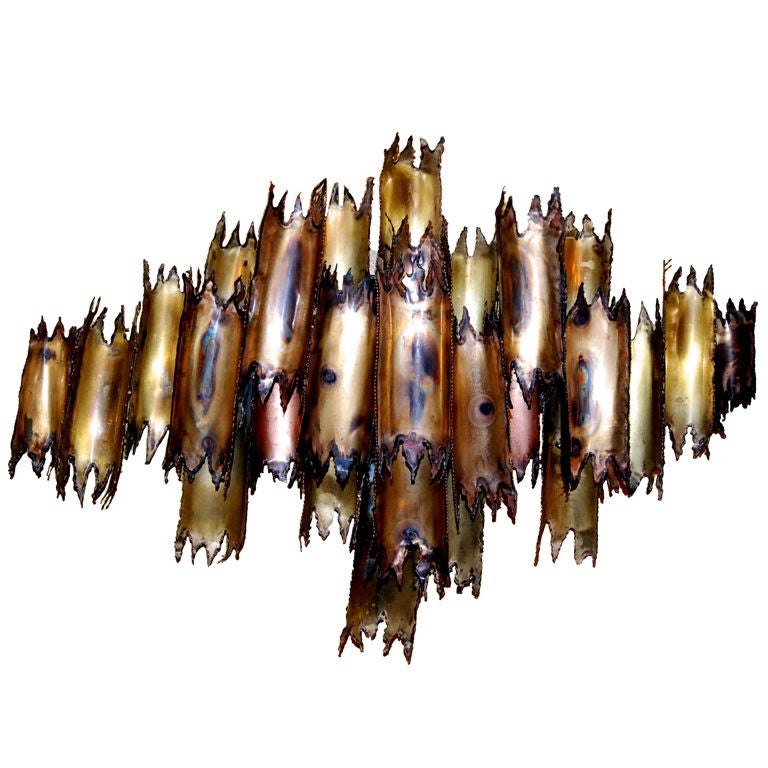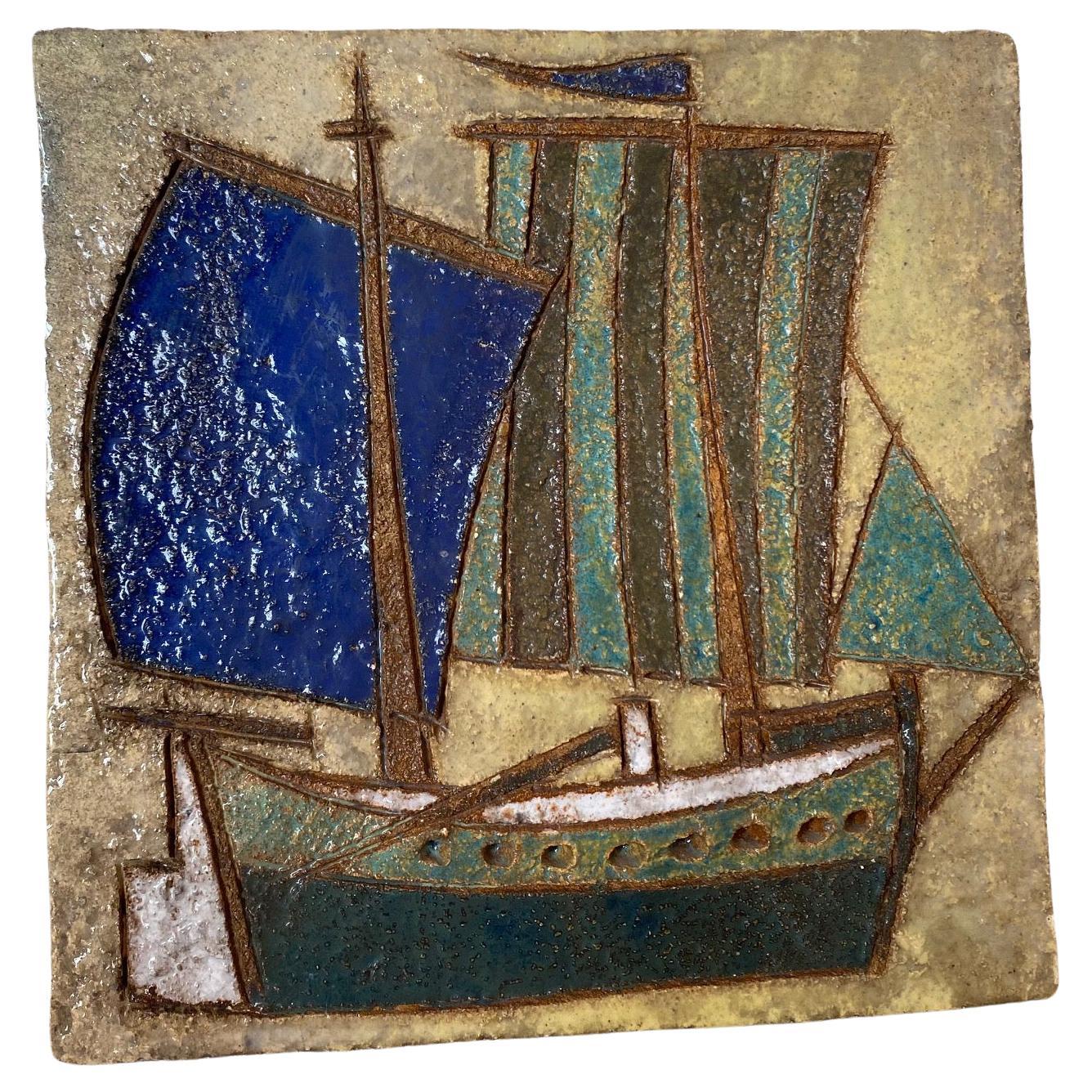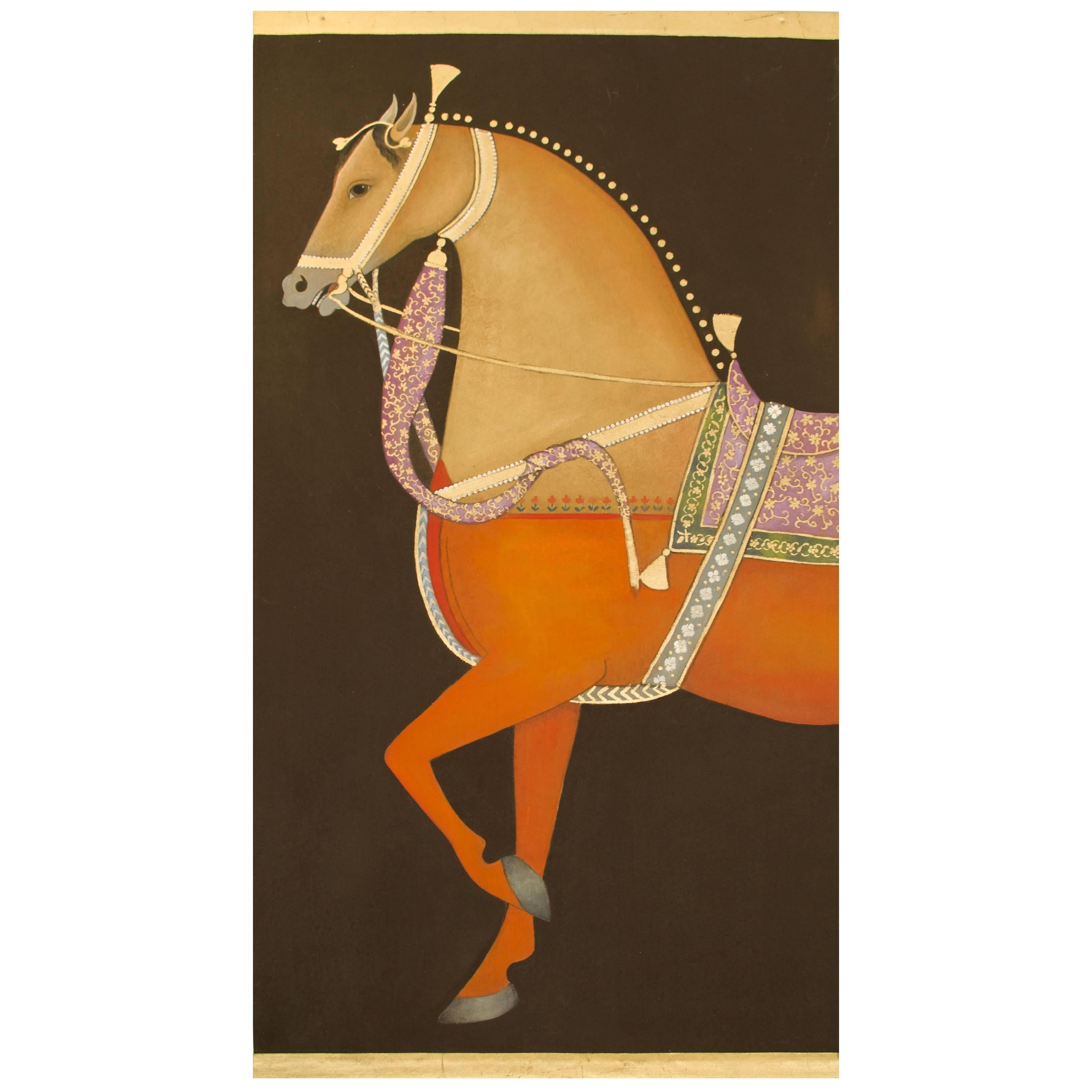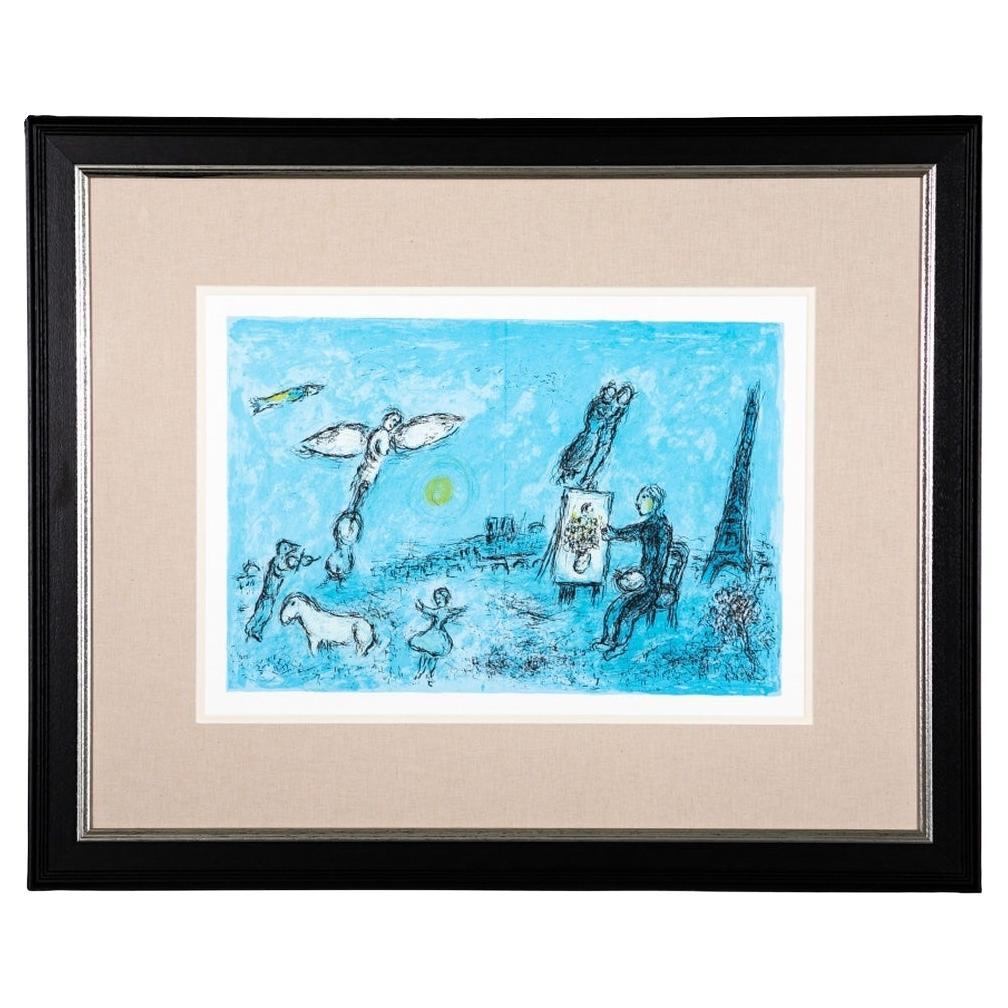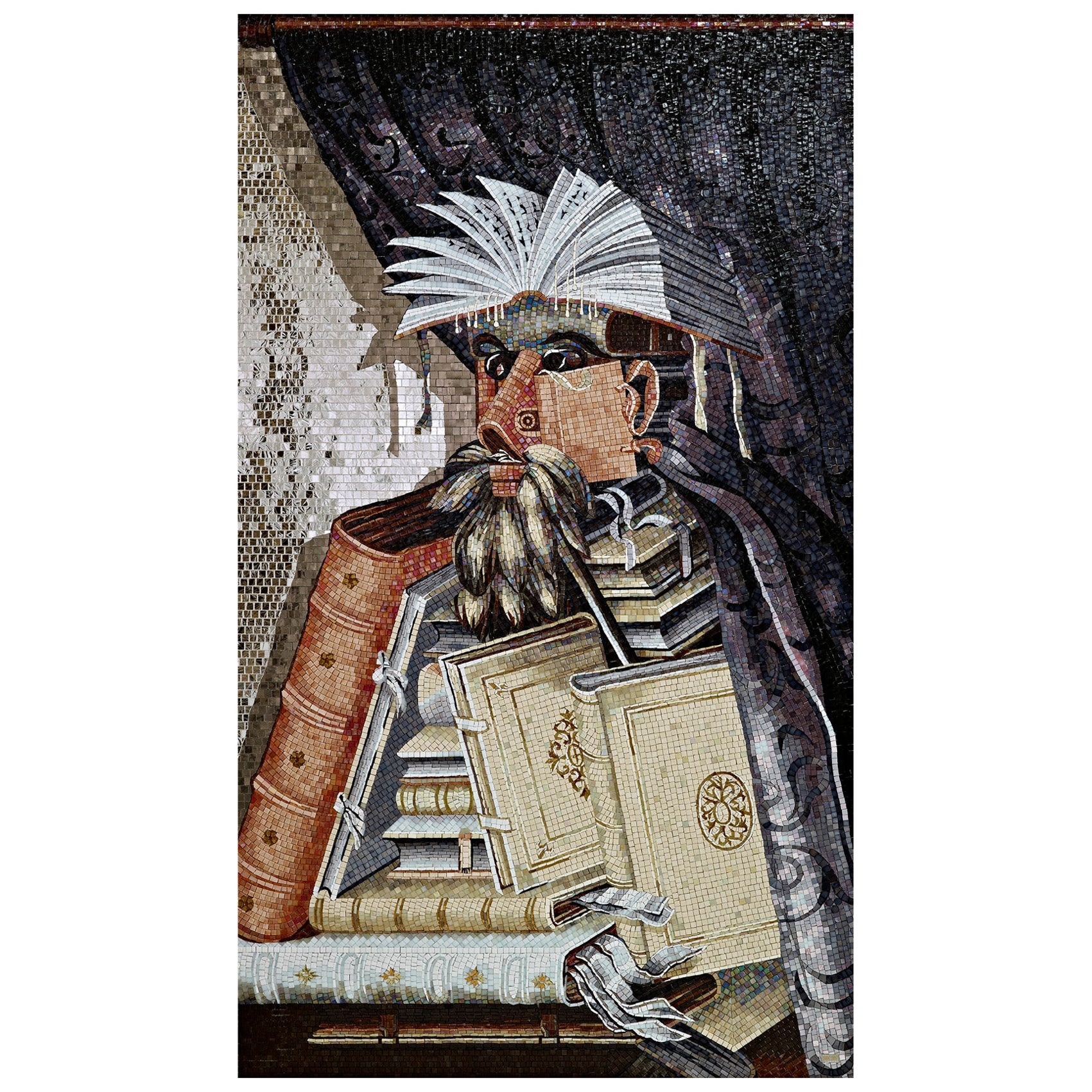Items Similar to Marc Roussel French Ceramist, Saint Portrait, Vallauris, 1960s
Want more images or videos?
Request additional images or videos from the seller
1 of 12
Marc Roussel French Ceramist, Saint Portrait, Vallauris, 1960s
About the Item
A very rare and beautiful portrait of a Saint, a polychrome ceramic signed hand on the reverse Marc Roussel.
Marc Roussel is the father in Law of François Lembo, as his son-in-law his work as a ceramist is very inspired by Byzantine art and Russian icônes.
This tendency quickly guided him to move towards the realization of Russian icons transcribed on the ceramic taking the decorations of the icons in iridescent ceramic, which shine around the halos of the saints.
The artist is known as a famous ceramist in Vallauris, the village known as France's clay capital. From the 1950s famous artists, attracted by the reputation of Vallauris, settled there, including Pablo Picasso.
- Creator:Marc Roussel (Artist)
- Dimensions:Height: 5.91 in (15 cm)Width: 5.91 in (15 cm)Depth: 0.79 in (2 cm)
- Materials and Techniques:
- Place of Origin:
- Period:
- Date of Manufacture:1960
- Condition:
- Seller Location:Paris, FR
- Reference Number:1stDibs: LU4817218193471
About the Seller
5.0
Vetted Seller
These experienced sellers undergo a comprehensive evaluation by our team of in-house experts.
Established in 2017
1stDibs seller since 2019
54 sales on 1stDibs
Typical response time: 17 hours
- ShippingRetrieving quote...Ships From: Paris, France
- Return PolicyA return for this item may be initiated within 14 days of delivery.
More From This SellerView All
- French Artist Charles Lapicque Tapestry Limited Edition 1/2 "Pelops", 1964By Charles LapicqueLocated in Paris, FranceExceptional limited edition 1/2 tapestry "Pelops" with certificate from a private collection, 1964. Ateliers Pinton brothers in Felletin, under the supervision of Pierre Baudouin 2ex + 1EA Editor Aram Iynedjian. The tapestry will be sold with its certificate of authenticity from the gallery. From the 15th century, the name of Pinton was associated with the Aubusson tapestry. Since then, over the generations, the Pinton family has largely contributed to the development of this fabulous cultural heritage until the creation in the 19th century, of the Felletin factory, in the department of Creuse. Even today, in these workshops, the craftsmen execute the same correct gestures with the same attention to detail and thus extend the chain of the history of the tapestry of tradition but also contemporary. The hand of specialists, the eye of designers and dyers and the taste of the most demanding clientele find their meaning in the fabric of the carpets. The excellence of French know-how, a living heritage society and custodian of Aubusson's cultural heritage, has always collaborated with great artists. The works of Charles Le Brun, Charles Lapicque, Pablo Picasso, Jean-Michel Othoniel, and many other big names in the world of painting, architecture, design, fell into the looms and know-how ancestral of this unique Creuse creator. Editor Aram Iynedjian Aram Iynedjian, Lausanne gallery owner and editor of tapestries from Braque, Estève and Lapicque, the latter meets Pierre Baudouin, the most famous of the cardboard painters of the time. The one who translated the works of Le Corbusier, Calder or Picasso into tapestry then collaborates with Charles Lapicque and they will develop a work of great richness. Lapicque came to realize these two summits which are "Pélops" and "Diane et Actéon". I realize that you should never try to describe a work of art Let’s look at it. Let us admire the science of composition, linear purity, technical perfection, the beauty of color, the truth of the drama. Let us see, if we can, the implacable presence of genius. "We will now understand that after having based a painting on the love of tapestry, it was relatively easy, and very tempting, to build a tapestry faithful to my painting," explained the artist in the exhibition catalog. of the Galerie Verrière in 1970. It was not until 1961 that he began to produce cardboards both for the tapestry of the Lisse in Aubusson, but also at the Mobilier National, with the help of Pierre Baudouin Charles Lapicque (1898-1988) Born in 1898 in Theizé (Rhône) in a family practicing both the arts and the sciences, Charles Lapicque is no exception to the rule: gifted for music and drawing, he graduated from the École Centrale in 1921, works as engineer until 1928 before integrating in 1931 a laboratory at the Faculty of Sciences of Paris, where he carried out research on the perception of colors, crowned by the title of Doctor of Physical Sciences in 1938. He thus studies the reactions of the eye in front of an intense light source, at the origin of the formation of starry images which he will use in his works, and defines a theory of the staggering of colors in space which overturns the rules of the Renaissance: "I had shown that the Classic rule, that of Vinci, advocating placing the blues in the distance, the reds, oranges and yellows in the foreground, is a nonsense; it makes more sense, more favorable to do the opposite. "(In Red and blue in the arts, 1936) It was around 1920 that Charles Lapicque began to paint in Brittany where he spent every summer since his childhood, first on the motif and then in a workshop that his stepfather Jean Perrin, Nobel Prize in Physics, had him build in 1927 ; he then definitively adopted the work of memory, in accordance with the art of music which he deeply loved and the Bergsonian philosophy of knowledge: "It is up to us to give reality an appearance that it has no itself, a form, a figure (...). " His youthful production immediately reveals a great originality, oscillating between figuration and abstraction which sometimes intertwine: alongside synthetic paintings by their simplified drawing and their flat colors, he designs an Homage to Palestrina (1925), composed of a grid derived from Cubism, entirely abstract, relayed by a Christ with Thorns (1939), according to a principle that he will develop after 1939, in line with his optical discoveries. In fact, during the war years, an almost abstract period began, that of the tight blue framework, applied to backgrounds ranging from yellow to red and revealing a more or less identifiable world (Jeanne d'Arc crossing the Loire, 1940; Rencontres series, 1940-1945). Exhibited in 1929 by the gallery owner Jeanne Bucher, Lapicque abandoned his scientific career in 1943 to devote himself entirely to painting. He continued his work which resulted in 1946-1953 in white-frame structures; their much softer lines lead him to the system of either black or white interlacing which encloses areas of pure color, most often in solid color. With The Battle of Waterloo in 1949, Lapicque still uses optics - zooming in on a given area - to depict spaces with multiple perspectives and decomposed times. This new interest in the liveliness of color developed in the following period, which can be described as flamboyant or Baroque (1954-1963): illustrated in particular by the series of Breton lagoons and twilight or nocturnal views of Venice in the light. Stars, which the artist himself describes as “daring sweets”, it begins with the Raoul Dufy Prize of the Venice Biennale, awarded in 1953 to the artist who took the opportunity to give free rein to his passion for the Serenissima until July 1956. Another point in common with his elder brother is the expression of movement. Begun in 1949 in The Battle of Waterloo then in 1952 with Dimanche aux regates, it became an obsession from 1964, in the exploration of new themes, such as the different shots of tennis players captured on the fly (1965), the mythological scenes and sea storms. These dizzying years precede the artist's last period: as he comes of age, he discovers serenity, revealed by a painting now with acrylic paint, much more peaceful from 1974, which even borders on a childish naivety at the end. of his life. All of his work includes an astonishing diversity of themes, also nourished by his travels (Rome in 1957, Greece in 1964, Holland in 1974 ...), with a predilection for the sea, rocks, sailboats, music, tennis, horses, wild beasts, but also for history and mythology, as evidenced by knights, kings and ancient gods. It also deploys, in total creative freedom, a wide variety of styles and orientations. Having been one of the pioneers of non-figurative art, thus paving the way for artists like Manessier, Bazaine, Vieira da Silva, De Staël, etc. Owners of the new non-figurative Paris School of the Postwar period, Charles Lapicque then returned to figuration, in a "new interpretation" of appearance, even if he continued to rub shoulders with abstraction at times. "Drawing runs after color and color after drawing. " Heir to the Fauves, Charles Lapicque plays like them on pure colors, whose dissonances, associated with a totally free design and an overloaded composition in a multiple space, make him a precursor of the New Figuration in all its forms: the Narrative Figuration born in France in the early 1960s, represented in particular by Gérard Fromanger, Erró, Bernard Rancillac and Gérard Guyomard; Free Figuration born in the early 1980s, marked by Robert Combas, Hervé and Richard Di Rosa, Louis Jammes and François Boisrond, and which, in turn, influenced the American Bad Painting of a Jean-Michel Basquiat or a Keith Haring, deliberately neglected and Expressionist; Lapicque's “Classic subjects” were able to feed Cultivated Painting, which also appeared in the early 1980s with Jean-Michel Alberola, Patrice Giorda and Gérard Garouste...Category
Mid-20th Century European Tapestries
MaterialsWool
- Large Vase French Ceramist J. Suzor geometric pattern, Craqueling GlazeLongwyLocated in Paris, FranceJacqueline SUZOR de PANAFIEU (1903 – 1981) Numbered Large vase signed J. Suzor, circa 1970 geometric pattern, cracked ceramic, creation Desert Occidental, collection "Santal" "Handmade in France, Faiencerie des Recollets". White-grey craqueling glazed, very beautiful pattern . Superb vintage condition, no repairs. Born in 1903 in Paris, Jacqueline studied drawing as a teenager. From the 1920s to 1935, she began a promising career as a painter. From Kiki to J.S. de PANA-FIEU, through Suzor, JSP or Pana (more than 6 signatures for one artist!), Jacqueline Suzor de Panafieu assumed several personalities during her life as a Parisian artist. Her signatures bear witness to a woman's life and career made up of ruptures and twists. Curious about everything and everyone, Jacqueline Suzor surrounded herself with artists, writers, filmmakers, actors and photographers who met at her table. She also met Dali and Giacometti. Jacqueline freed herself from the cubist influence, she defined herself in the 1930s, an aesthetic that came from her passion for the Far East, developed through contact with the objects brought back by her ambassador father during his distant travels. Two artists inspired her during the period from 1957 to 1962: Bernard Buffet and Georges Matthieu. From one she borrowed the black lines; from the other she owed her passage to abstraction. Her numerous exhibitions in the 1970s brought her recognition in France and abroad. It was also a time of commitment within the Union of Women Painters and Sculptors (UFPS), of which she became vice-president. MAIN EXHIBITIONS : 1933 - Salon de la Société Nationale des Beaux Arts, Grand Palais, Paris. 1959 - Gallery Mourgue, Paris. Personal exhibition (EP). 1961 - Salon Comparaisons. 1962 - Gallery Hoche, Paris. 1970 - Town hall of Montrouge. M.J.C., Montreuil. Athanor Gallery, Pana Interior Museum, le Véşinet...Category
Mid-20th Century Vases
MaterialsCeramic
- Vase Ball French Ceramist J. Suzor Geometric Pattern, Craqueling GlazelongwyLocated in Paris, FranceJacqueline SUZOR de PANAFIEU (1903 – 1981) Numbered vase signed J. Suzor, circa 1970 geometric pattern, in Art Deco's style, cracked ceramic, creation Desert Occidental, collection "Rouge-Gorge" "Hand made in France, Faiencerie des Recollets". White craqueling glazed, very beautiful pattern and bright colors. Superb vintage condition, no repairs. Born in 1903 in Paris, Jacqueline studied drawing as a teenager. From the 1920s to 1935, she began a promising career as a painter. From Kiki to J.S. de PANA-FIEU, through Suzor, JSP or Pana (more than 6 signatures for one artist!), Jacqueline Suzor de Panafieu assumed several personalities during her life as a Parisian artist. Her signatures bear witness to a woman's life and career made up of ruptures and twists. Curious about everything and everyone, Jacqueline Suzor surrounded herself with artists, writers, filmmakers, actors and photographers who met at her table. She also met Dali and Giacometti. Jacqueline freed herself from the cubist influence, she defined herself in the 1930s, an aesthetic that came from her passion for the Far East, developed through contact with the objects brought back by her ambassador father during his distant travels. Two artists inspired her during the period from 1957 to 1962: Bernard Buffet and Georges Matthieu. From one she borrowed the black lines; from the other she owed her passage to abstraction. Her numerous exhibitions in the 1970s brought her recognition in France and abroad. It was also a time of commitment within the Union of Women Painters and Sculptors (UFPS), of which she became vice-president. MAIN EXHIBITIONS : 1933 - Salon de la Société Nationale des Beaux Arts, Grand Palais, Paris. 1959 - Gallery Mourgue, Paris. Personal exhibition (EP). 1961 - Salon Comparaisons. 1962 - Gallery Hoche, Paris. 1970 - Town hall of Montrouge. M.J.C., Montreuil. Athanor Gallery, Pana Interior Museum, le Véşinet...Category
Vintage 1970s French Vases
MaterialsCeramic
- Mallard Duck Desk or Smoker Set in Paris Porcelain, 1960sBy Porcelaine de ParisLocated in Paris, FranceA mallard duck desk or smoker set in Parisian porcelain, composed of an ashtray, a desk tray, a business card box and a tobacco jar dressed in cellar leather...Category
Late 20th Century French Desk Sets
MaterialsLeather, Porcelain
- Fabulous Vintage Ruby Red French Crystal Table Lamp by Saint Louis ManufactureBy Cristalleries De SevresLocated in Paris, FranceExceptional and very rare handcut table lamp is in a clear and rich ruby red color double-layered crystal, it is a piece who required time for her shaping, outline, engrave and notch...Category
Late 20th Century French Table Lamps
MaterialsCrystal
- Rare Early Le Corbusier LC4 Chaise Lounge Cassina Signed Nr. 737, 1960sBy Pierre Jeanneret, Cassina, Charlotte Perriand, Le CorbusierLocated in Paris, FranceRare and beautifully preserved for it age LC4 chaise longue, this a very early number 737 signed Le Corbusier. This lounge chair is original, edition from 1960. This LC4 lounge chair for Cassina is in a superb vintage condition, with adjustable polished chrome-plated steel frame and innovative self-supporting mattress, covered in original black leather mattress furry skin and black skin headrest. with a very beautiful patina and has no structural issues no tearing just the patina that goes with the times, Designed in 1928, the tilting lounge chair that does not yet bear the LC4 chair...Category
Mid-20th Century French Bauhaus Chaise Longues
MaterialsSteel, Chrome
You May Also Like
- 1960s Wall SculptureLocated in Cathedral City, CABrass and copper wall sculpture.Category
Vintage 1960s American Mid-Century Modern Decorative Art
MaterialsBrass, Copper
- Les Argonautes Ceramic Panel, France, Vallauris, 1960sBy Les ArgonautesLocated in Paris, FRLes Argonautes (Frédérique Bourguet and Isabelle Ferlay), French workshop created in Vallauris, south of France, in 1953 and active until the death of Frederique Bourguet in 1997.Category
Vintage 1960s French Decorative Art
MaterialsCeramic
- Les Argonautes Ceramic Panel, France, Vallauris, 1960sBy Les ArgonautesLocated in Paris, FRLes Argonautes (Frédérique Bourguet and Isabelle Ferlay), French workshop created in Vallauris, south of France, in 1953 and active until the death of Frederique Bourguet in 1997.Category
Vintage 1960s French Decorative Art
MaterialsCeramic
- Equestrian Portrait Painted on Linen with Gold Leaf by French ArtistLocated in Saint-Ouen, FRPainted on linen Gold highlights French contemporary work Hand-painted.Category
2010s French Decorative Art
MaterialsAcrylic, Linen
- Marc Chagall '1887-1985' Color Lithograph, the Painter and His Double M.992By Marc ChagallLocated in Bridgeport, CTPrinted in 1981 for the art magazine "Derriere le Miroir" #246. The painter paints himself in a Paris setting with the Eiffel Tower and Notre Dame. Musicians, an angel, flowers and a...Category
20th Century Mid-Century Modern Decorative Art
MaterialsPaper
- Artistic Mosaic Handmade Portrait Wall Decor Dimension and Colors CustomizableBy sicisLocated in London, GBMaking artistic Mosaic, design of unparalleled beauty, inventing' tromp l'oeil' thanks to the endless colors of the glass Mosaic collections, all this allowed us to produce and divul...Category
21st Century and Contemporary Italian Modern Contemporary Art
MaterialsGlass
Recently Viewed
View AllMore Ways To Browse
Polychrome Saint
Byzantine Icons
Russian Antique Icon
Antique Icons Russian
Antique Russian Icon
Antique Russian Icons
Antique Russian Icon Icons
Russian Antique Icons
Russian Icon Antique
Francois Lembo
Antique Byzantine Icon
Lat Table
Ramon Horts
Tyler Graphics
Vintage Tunisie
Bug Bear
Damien Hirst Pharmacy Wallpaper
Fremantle Vintage
